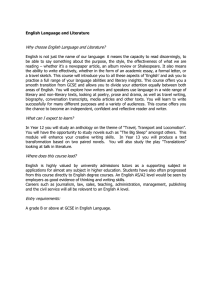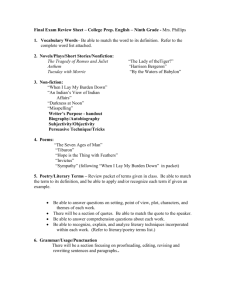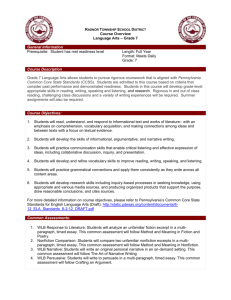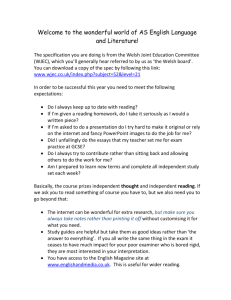II Aims and Objectives of IB MYP Language A
advertisement
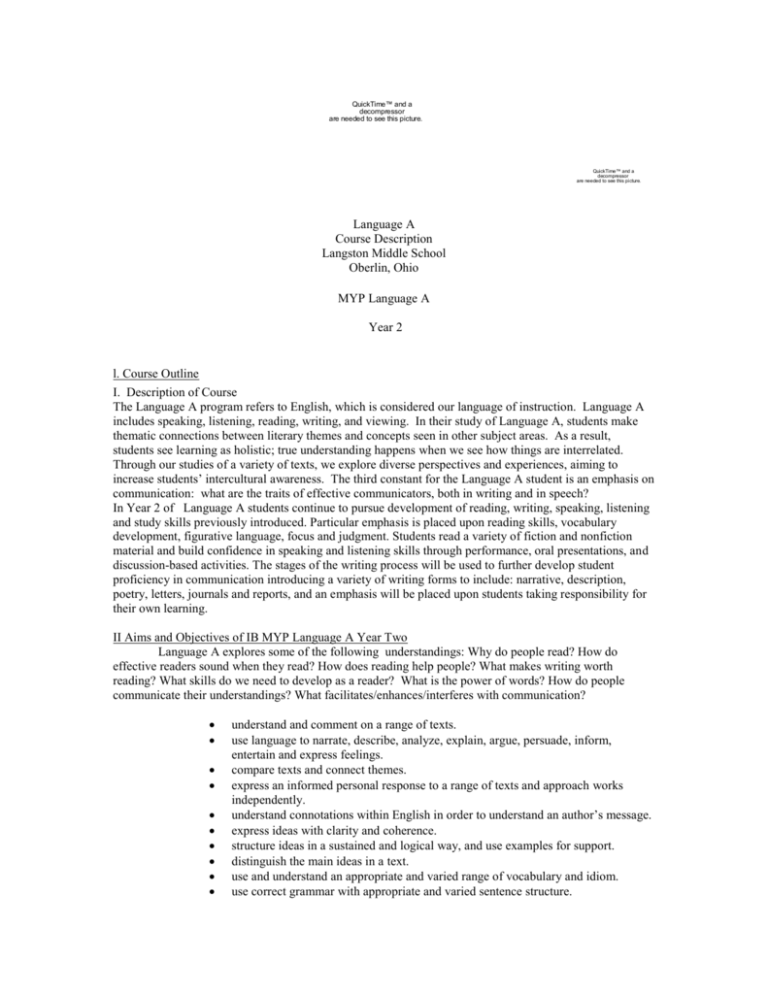
QuickTime™ and a decompressor are needed to see this picture. QuickTime™ and a decompressor are needed to see this picture. Language A Course Description Langston Middle School Oberlin, Ohio MYP Language A Year 2 l. Course Outline I. Description of Course The Language A program refers to English, which is considered our language of instruction. Language A includes speaking, listening, reading, writing, and viewing. In their study of Language A, students make thematic connections between literary themes and concepts seen in other subject areas. As a result, students see learning as holistic; true understanding happens when we see how things are interrelated. Through our studies of a variety of texts, we explore diverse perspectives and experiences, aiming to increase students’ intercultural awareness. The third constant for the Language A student is an emphasis on communication: what are the traits of effective communicators, both in writing and in speech? In Year 2 of Language A students continue to pursue development of reading, writing, speaking, listening and study skills previously introduced. Particular emphasis is placed upon reading skills, vocabulary development, figurative language, focus and judgment. Students read a variety of fiction and nonfiction material and build confidence in speaking and listening skills through performance, oral presentations, and discussion-based activities. The stages of the writing process will be used to further develop student proficiency in communication introducing a variety of writing forms to include: narrative, description, poetry, letters, journals and reports, and an emphasis will be placed upon students taking responsibility for their own learning. II Aims and Objectives of IB MYP Language A Year Two Language A explores some of the following understandings: Why do people read? How do effective readers sound when they read? How does reading help people? What makes writing worth reading? What skills do we need to develop as a reader? What is the power of words? How do people communicate their understandings? What facilitates/enhances/interferes with communication? understand and comment on a range of texts. use language to narrate, describe, analyze, explain, argue, persuade, inform, entertain and express feelings. compare texts and connect themes. express an informed personal response to a range of texts and approach works independently. understand connotations within English in order to understand an author’s message. express ideas with clarity and coherence. structure ideas in a sustained and logical way, and use examples for support. distinguish the main ideas in a text. use and understand an appropriate and varied range of vocabulary and idiom. use correct grammar with appropriate and varied sentence structure. Show awareness of the need to adjust tone to suit the audience and task. From this framework and the direction provided by Ohio State Standards, IB subject guide requirements and precedents and expectations of this school district, Language A explores six major topics: 1. Literature (short stories, novels, poetry, biographies, journalism and nonfiction) 2. Writing (informal, formal, and technology related) 3. Research (source evaluation, corroboration and refutation, MLA documentation, and technology applications) 4. Grammar, Usage and Mechanics (capitalization, punctuation, parts of speech) 5. Acquisition of Vocabulary and Spelling (etymology, affixes and roots, literature-related word lists) and 6. Oral, Listening and Visual Communication (oral presentations, impromptu oral responses, small-group discussions) lll. Reas Of Interaction: Topics of Study Narrative Writing: What is your story? Expository: How does what you do affect others? Persuasion: How do we prevent ourselves from falling prey to advertisers? Research: Do we really know all we need to know? How can research give us a global understanding? Literary Focus Interpreting a Literary Work: Do we really understand the nature of our interpretations? Is it necessary for us to interpret literary works? Analyzing Unsupported Inferences and Fallacious Reasoning: Do they really mean what they say? Literary Focus Analyzing Setting and Its Influence on Mood and Tone: Can setting have an impact on us as individuals? Areas of Interaction Human Ingenuity- Students recognize the impact of their creations through narrative writing. How does the story affect the reader? Community and Service-Students examine how psa’s influence the community, prompting positive action. Human Ingenuity-Students use propaganda techniques to understand the impact of propaganda. Environments-Students study different environments to find solutions to common issues. Environments-Students consider a wide range of literary works to determine impact on that particular environment. Human Ingenuity- During this unit, students explore the necessity for analysis of works prone to fallacious reasoning. Health and Social Education-Students look at ways in which mood and tone reflect the author’s purpose. lV. Resources: TEXTBOOKS: Write Source, Houghton Mifflin Company, 2005 Literature, Course 2, Glencoe Additional resources include, but are not limited to, the following novels: Novels: The Outsiders, S.E. Hinton Farewell To Manzanar, Jeanne Wakatsuki Houston and James D. Houston Robert Louis Stevenson Don’t You Dare Read This Mrs. Dunphrey, Margaret Peterson Haddix Where The Red Fern Grows, Wilson Rawls The Watsons Go To Birmingham,Christopher Paul Curtis The True Confessions Of Charlotte Doyle V. Methodology What defines learning and serves as indicators of growth in understanding of the dynamics of literacy acquisition and learning situate the teaching methods and assessments for Language A. Differentiated instruction is an invaluable tool designed to address the needs of the whole child. Lesson planning employs the concepts of global understanding.: All cultures read. Reading is a lifelong skill. Reading has multiple purposes and forms that change from one culture to another. Not everything people read appears the same. Writing stabilizes and preserves ideas. Writing processes thoughts and feelings. Grammar and mechanics standardize and provide cultures with uniform communicative structures. Research provides a methodical process and format for gathering, evaluating and sharing information. Communication encompasses multiple modes that process and transmit ideas and feelings through sensory elements. VI. Methods of Assessment Students’ understanding of content and mastery of skills is measured in a variety of ways, including essays, responses to literature, creative writing, performance, self-reflection journals, group discussions, projects that appeal to multiple intelligences, Socratic seminars, research projects, oral presentations, poetry, tests, quizzes, skits, critiques, and debates. VII. Grading Policy Currently, students receive traditional scores (A-F in correspondence to the 100 point scale) for end of unit assessments, quizzes, homework, and organization and participation. At the culmination of each IB unit, students complete an assessment that is scored using the IB rubric; the score for the final assessment is correlated to the 100 point scale. For these IB assessments, students are scored on Content, Organization, and Style and Language Mechanics.
